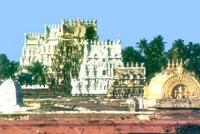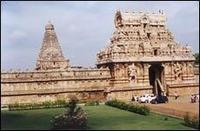Trichy
 Trichy is on the bank of river Cauvery, and is the 4th largest city in Tamilnadu, and it is mountaineous. There are mountains inside the city, and you will be driving around mountains, small ones though, if you want to get to any place.
Trichy is on the bank of river Cauvery, and is the 4th largest city in Tamilnadu, and it is mountaineous. There are mountains inside the city, and you will be driving around mountains, small ones though, if you want to get to any place.You can get to Trichy from Chennai by train or the road. Train is preferred, coz it takes just about 5 hrs to reach, and it is a over night journey. You need to take the Rock Fort Express from Chennai Egmore Station. Trichy is called Rock Fort City, coz there is a temple fort on top of a small hillock, that is dedicated to the favorite God of Hindus, the Ganesha.
I had gone to Trichy on work, and i stayed back there for the weekend, so that I can go around and see the places around. The Ranganatha Swamy temple and the Uchi Pulaiyar Temple ( Summit Ganesha ) ie the Rock Fort Temple on top of the hillock are a must see.
Tiruchirappalli, was a citadel of the early Cholas which later fell to the Pallavas. Trichy is a fine blend of tradition and modernity built around the Rock Fort. Apart from the Fort, there are several Churches, Colleges and Missions dating back to the 1760s. The town and its fort, now in Trichy were built by the Nayaks of Madurai. This city has given great Tamil scholars whose contributions to the Tamil literature have been very significant.
Rock Fort Temple - The most famous land mark of Trichy is the Rock fort and Temple. It is perched on a massive 83 m rock which rises abruptly from the plain to tower over the old city. The actual centre of attraction is not the fort itself, of which very little remains, but the temple at the summit.
The Nayaks made use of its naturally fortified position, but the temple was built by the Pallavas as a small cave temple. ( The same Pallavas, who did the Shore temples in Mahabalipuram, near Chennai ). It is a stiff climb, up the 437 steps cut into the stone to the top but well worth the view. There are inscriptions dating back to the 3rd century.B.C. Hardly anything remains of the ramparts but the Main Guard Gate is still intact.
It was one of the main centers around which the wars of the Carnatic were fought in the 18th century during the British-French struggle for supremacy in India. And according to an inscription, this place contributed to the British laying the foundation of their Empire in India.
At the top of the rock is the Uchipillaiyar Koil, a temple dedicated to Lord Vinayaka from where one can enjoy a panoramic view of Tiruchirappalli. A flight of steps leads to the Mathrubutheswarar of Thayumanaswami temple, dedicated to Lord Siva where the lingam is a projection of the rock itself. Below the Siva temple are the two Pallava cave temples that have beautiful sculptures of the 6th and 7th centuries.
Non-Hindus are not allowed into the Vinayaka Temple at the summit and at the bigger Sri Thayumanaswamy Temple dedicated to Siva, halfway up.
From the top of the hillock, from the temple, the view of Trichy is beautiful, with Cauvery flowing on one side. All along the river, you will find women washing clothes, kids playing in the water, men bathing their buffaloes, the sight is wonderful – so very Indiaish.
At the foot of the Rock Fort are a tank and a pavilion which are used during the float festival of the temples. Near the tank is the house where Robert Clive lived when he was in Tiruchirappalli and there is an 18th century Church built by Reverend Schwartz of Denmark.
Ranganath Swamy Temple - This superb temple complex at Srirangam is on an island, surrounded by the Cauvery and its tributary Kolidam. It is about three kms from the Rock Fort, is a 600 acre island-town surrounded by seven concentric walls with 21 gopurams and is probably the largest in India. Most of it dates from the 14th to 17th centuries, and many people have had a hand in its construction, including the Cheras, Pandyas, Cholas, Hoysalas and rulers from Vijayanagar. The largest gopuram in the first wall on the southern side was completed as recently as 1987, and now measures 73m
The main temple is dedicated to Vishnu. Even muslims are said to have prayed here after the fall of the Vijayanagar Empire. Non-Hindus are not allowed into the gold - topped sanctum, but they are allowed into the sixth wall. The whole place is fascinating. Bazaars and Brahmins' houses fill the space between the outer four walls, and you don't have to take your shoes off or leave your 2 wheeler until you get to the fourth wall. Just past the shoe deposit is an information centre, where you buy the ticket to climb the wall for a panoramic view of the entire complex. There's also a small museum containing sculptures.
Ivory sculptures of Lord Vishnu in various poses and the images of Nayak Kings with consorts donated by Nayak kings who ruled Madurai during the 17th century are available here.
Pavai lamps of Marati period who ruled Thanjavur, the rest of the period, made the Nataraja image in a pearl made screen. Coins of British, Dutch, Tiruvanquor, Hyderabad, Gwalior, princely states are available. Firm leaves inscriptions, stone sculptures, very big temple lamps, copper plates of Vijayanagara Kings are available .
After visiting these places, the Rock fort and temple, the Srirangam temple and the museum, you will feel completely elated. You can take a walk around the city, and get back home.
Getting There :
Trichy is well connected.
By Air : Trichy has an airport (5 kms from the city). Indian Airlines connects Trichy with Chennai, Sharjah, Kuwait and Colombo. Air Lanka Service connects Tiruchirapalli with Colombo.
By Train : Trichy is an important junction on the Southern Railway
By Road : Trichy is well connected by road with important places and Southern Cities
Getting Around : City Bus service, Tourist Taxis, Auto Rickshaws and Cycle Rickshaws are also available.
Trip Duration : 2 days
Accomodation :
Jenny’s Residency, 3 / 14, McDonalds Road, Trichy, Ph : 2461301, 2414414
Femina Hotel, 14 – C, Williams Road, Trichy, Ph : 2414501, 2414274
Hotel Abirami, 10, McDonalds Road, Trichy, Ph : 2415001
Hotel Ajanta, 6 – A, Rockins Road, Trichy, Ph : 2415501
Hotel Anad, No. 1, Racquet Court Lane, Trichy, Ph : 2415545

